The development of new types of soft robotic structures, and especially materials and methods for the fabrication of such robots, requires and offers rich new opportunities for collaborations involving organic chemistry, soft materials science, and robotics. This project centers on a methodology based on embedded pneumatic networks that enables large amplitude actuation in soft elastomers by pressurizing embedded channels.
Most traditional robotic systems are hard, that is, composed of metallic structures with joints based on conventional bearings. Although hard robots capable of movement often possess limb-like structures similar to those of animals, more often, structures not found in nature – for example, wheels and treads – are used. Hard robots are typically actuated and controlled electronically, and require interfacing with a computer to function.
In contrast to hard robots, some locomotive systems (e.g., hexapods, including beetles, ants, and crickets) use the passive compliance of air within pneumatic cylinders to move quickly on rough terrain. The tentacles of squid, trunks of elephants, and tongues of lizards and mammals are similar examples; their structures are muscular hydrostats. Squid and starfish are highly adept locomotors, but their modes of movement have not been productively used in conventional hard robotics. These soft actuators rely on elastomeric structures and fibril arrangements of muscles that result in bending, elongation, or contraction without significant changes in the overall volume of the structure.
Using biomimetic principles based on these characteristics, we are developing partially or entirely “soft” robots, fabricated in materials (predominantly elastomeric polymers) that do not use a rigid skeleton to provide mechanical strength, and are actuated pneumatically. Soft robots are simpler to make and less expensive than conventional hard robots, and may, in some respects, be more capable of complex motions and “cooperative function” (that is, safe operation around humans). Simple, inexpensive systems will probably not replace more complex and expensive ones, but may have different uses.
Elastomeric Grippers, Tentacles, and Walkers
Our designs use networks of channels in elastomers that inflate like balloons for actuation. Using a series of parallel chambers embedded in elastomers as a repeating component and then stacking or connecting these components enables us to design and test prototype structures providing complex movements by intuition (empirically). Complex motion requires only a single source of pressure, and the movement can be designed by appropriate selection of the distribution, configuration, and size of the embedded pneumatic network. Using the techniques described here, we have demonstrated soft machines that act as compliant grippers for handling fragile objects (e.g., an uncooked chicken egg, a live mouse) without damaging them (Figure 1), soft robots capable of tethered locomotion (Figure 2), and soft robots that can act as flexible tentacles (Figure 3) [1-3].
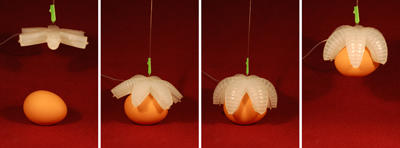
|
Fig. 1: A 9-cm tip-to-tip pneu-net gripping an uncooked chicken egg. A string suspends the gripper and assists in lifting the egg; a tube, visible on the left side of the gripper, runs into the central portion of the gripper to provide pressurized air for actuation. |
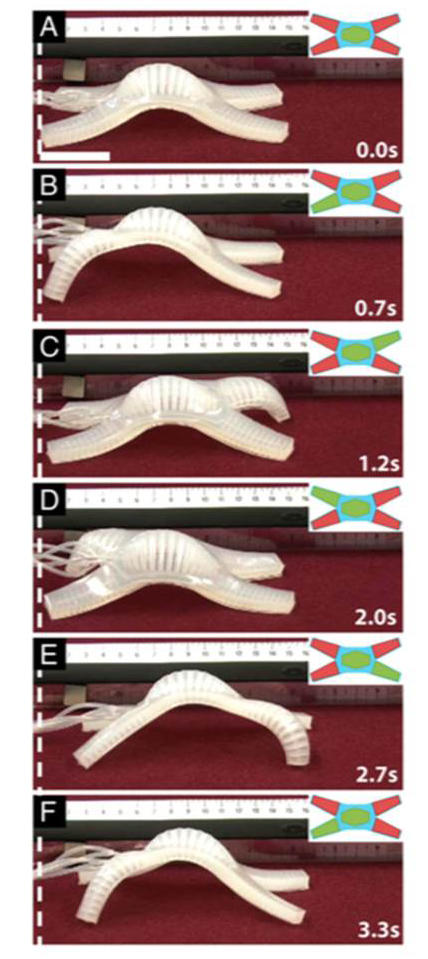
|
Fig. 2: Cycle of pressurization and depressurization of PNs that results in crawling. The particular PN(s) pressurized in each step are shown (insets) as green, and inactive PN(s) are shown (insets) as red. The scale bar in A is 4 cm. |
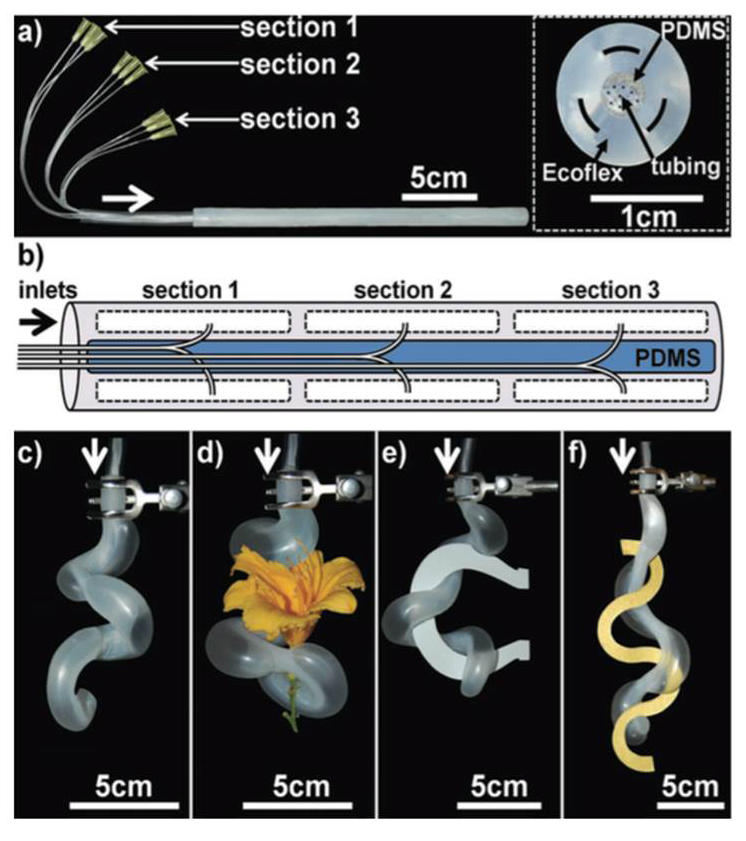
|
Fig. 3: 3D tentacles with multiple sections. a) Three-sectioned tentacle with nine independent microchannels, each controlled independently by an external source of pressure. The inset shows the cross section of the tentacle with the tubing traveling along the PDMS central channel. b) Schematic describing the distribution of the tubing inside the tentacle (not to scale). c) Tentacle with three sections inflated simultaneously. d) Tentacle holding a flower by conforming its three sections to the flower. e) Tentacle holding a horseshoe-shaped object. f) Tentacle with four sections holding a complex shape. |
Our previous designs of pneu-nets have achieved motion with large amplitudes, but only relatively slowly (over seconds). We have developed a new design for pneu-nets that reduces the amount of gas needed for inflation of the pneu-net, and thus increases its speed of actuation [4]. A simple actuator (Figure 4) can bend from a linear to a quasi- circular shape in 50 ms when pressurized at ΔP = 345 kPa. This actuator can operate over a million cycles without significant degradation of performance.

|
Fig. 4: Independent Output Control. A) Images from two views of four fPN actuators playing a tune on a digital keyboard. Video is available in the on-line supplemental information. Each fPN was actuated for 75 ms at 103 kPa (except for repeated notes, which were actuated for 50 ms) and vented for 150 ms. B) Spectrum analysis of the audio file for frequencies between 200 and 500 Hz. |
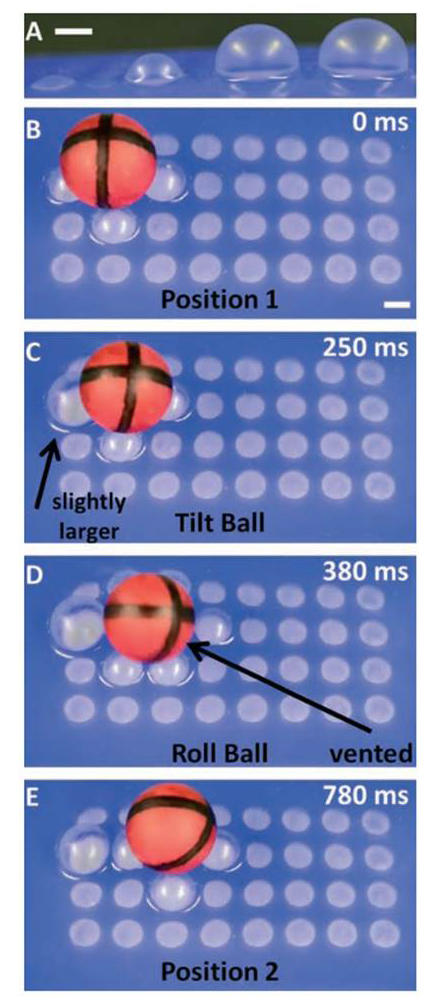
|
Fig. 5: Manipulating a ball with an array of expandable chambers. A) Four chambers expanded at a constant inlet pressure of 5 psi (34 kPa) for 100 ms, 250 ms, 500 ms, 1000 ms (left to right). B–E) Time-lapse images of a ball moved to the right by systematic expansion of the chambers in the array. B) The ball held in place by four chambers expanded for 250 ms. C) The ball tilted to the right by further expanding the chamber to the left of the ball for an additional 250 ms. D) The ball rolling to the right upon venting of the chamber to the right of the ball. The four chambers around the next position of the ball expand to guide the movement of the ball. E) The ball held in place in its new position. The left-most chamber, previously used to tilt the ball, is venting. |
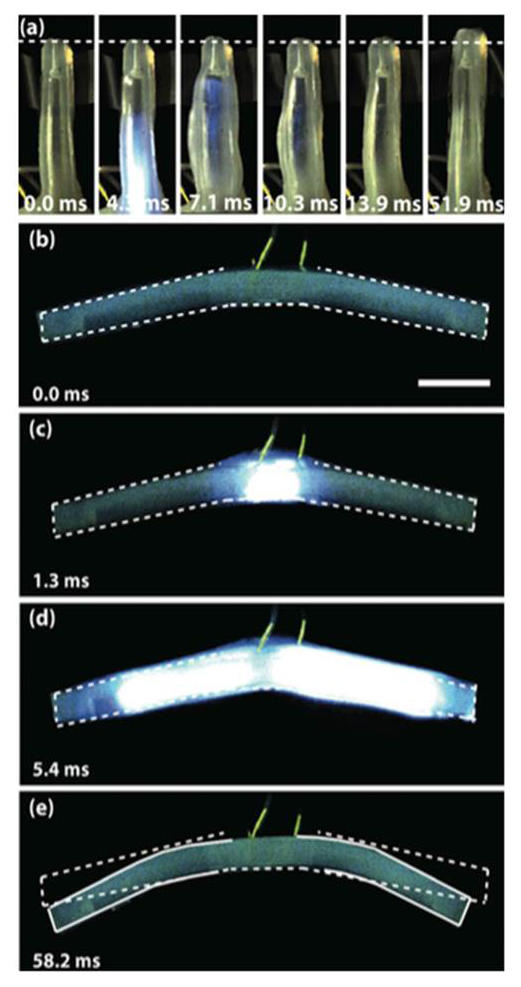
|
Fig. 6: Optical micrographs of a pneu-net while being explosively actuated, acquired using a high-speed camera. a) Top view of a leg of the tripod. Left to right: An electrical arc (0.0 ms) triggers explosive combustion of methane with a visible flame that persists for 10.3 ms. At 7.1 ms, a soft valve prevents propagation of the flame and pressure wave during the explosion. After 50 ms, the stored elastic energy stretches the pneu-net. Side view of the tripod b) before and c) after ignition of methane oxidation. d) The flame front propagates to the end of the pneu-nets and e) the stored elastic energy is released as a downward motion. Scale bar = 2 cm. |
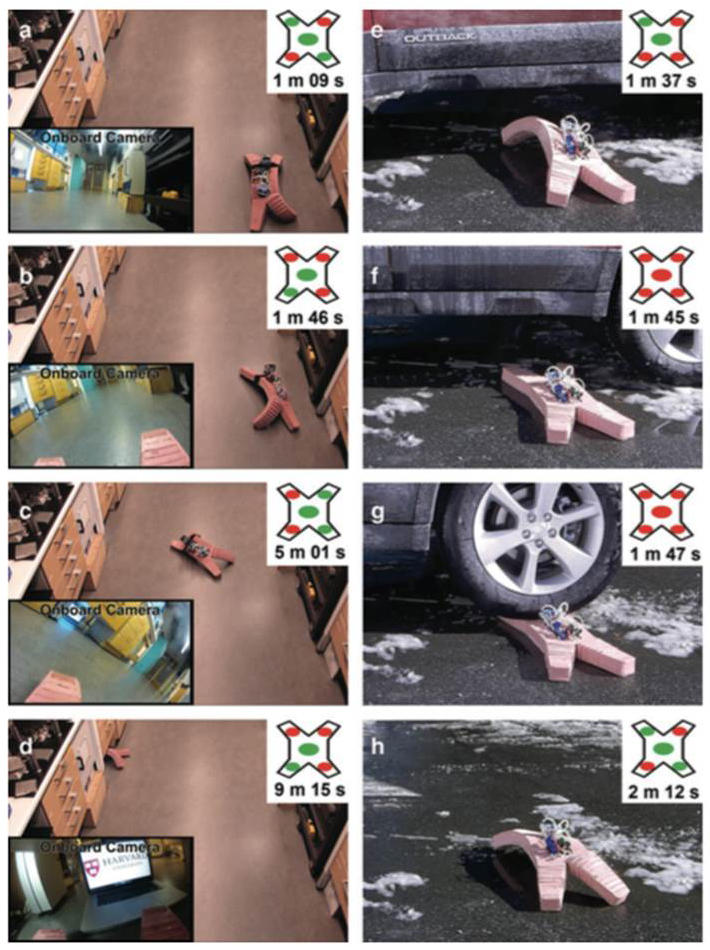
|
Fig. 7: Untethered operation of the quadrupedal soft robot. (a–d) Untethered soft robot conducting indoor surveillance with the view of the onboard camera overlaid. The robot starts moving forward with a straight ambulatory gait (a). The robot switches to a turning gait to explore a passageway on the left (b, c). The robot uses its onboard camera to image a hidden laptop (d). (e–h) Untethered soft robot operating outdoors before and after being run over by a car (e). The robot depressurizes its actuators in preparation for impact (f). The car running over the elastomeric legs of the soft robot (g). The soft robot actuating and standing up after being ran over by the car (h). |
Buckling is typically regarded as a failure mode of most materials and structures, as it causes permanent damage (e.g., to metal frames, concrete pillars, etc.). The buckling of elastomeric materials, however, is reversible, and can provide useful new functions when designed properly. We have used buckling of elastomers to generate a rotary motion that provides a torque when interior pressure is less than exterior, providing a new mechanism for actuation; Upon application of negative pneumatic pressure, elastic beam elements in these actuators undergo reversible, cooperative collapse, and generate a rotational motion (Figure 8) [8].
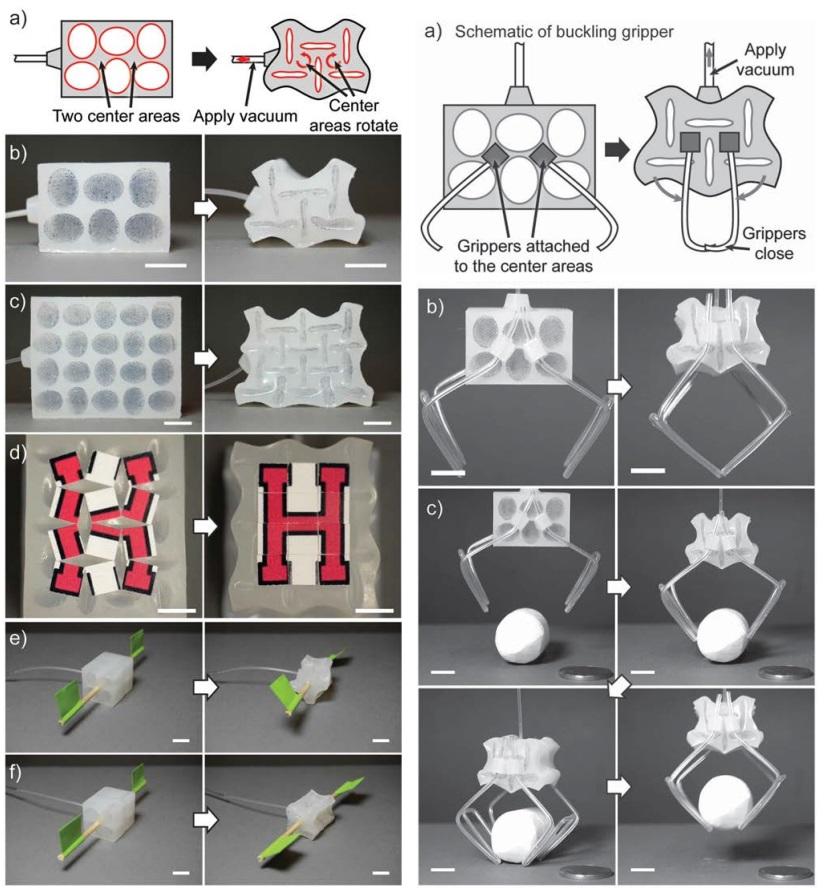
|
Fig. 8: At left: parallel actuation and stackability of the buckling structure. a) Schematics of buckling actuator with two actuation units. b) Buckling actuator with two actuation units. c) Buckling actuator with 3 × 4 actuation units. d) Using buckling actuators to realize parallel actuation. The square tiles are simultaneously moved in a concordant way by the 3 × 4 buckling actuator to form the letter “H”. e) Stacking two buckling actuators that rotate in the same direction. f) Stacking two buckling actuators that rotate in different directions. At right: soft gripper made of a buckling actuator. a) Schematics of the buckling gripper. b) The claws of the gripper close upon deflation of the buckling actuator. c) The buckling gripper picks up a piece of chalk. Scale bars are 1 cm. |
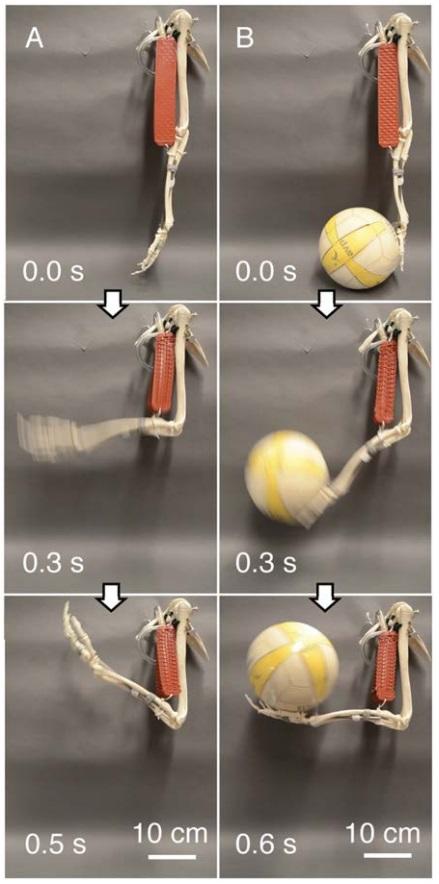
|
Fig. 9: Demonstration of muscle-like actuation. A) Use of a vacuum actuator to actuate a polymer replica of the bones of a human arm, with mechanics similar to that employed by a human bicep muscle. Here metal wires serve as “tendons” to connect vacuum actuator and replica bone, but high tensile strength polymer fibers could serve equally well. B) The vacuum actuated “arm” lifting a volleyball of standard size and weight (274 g). |
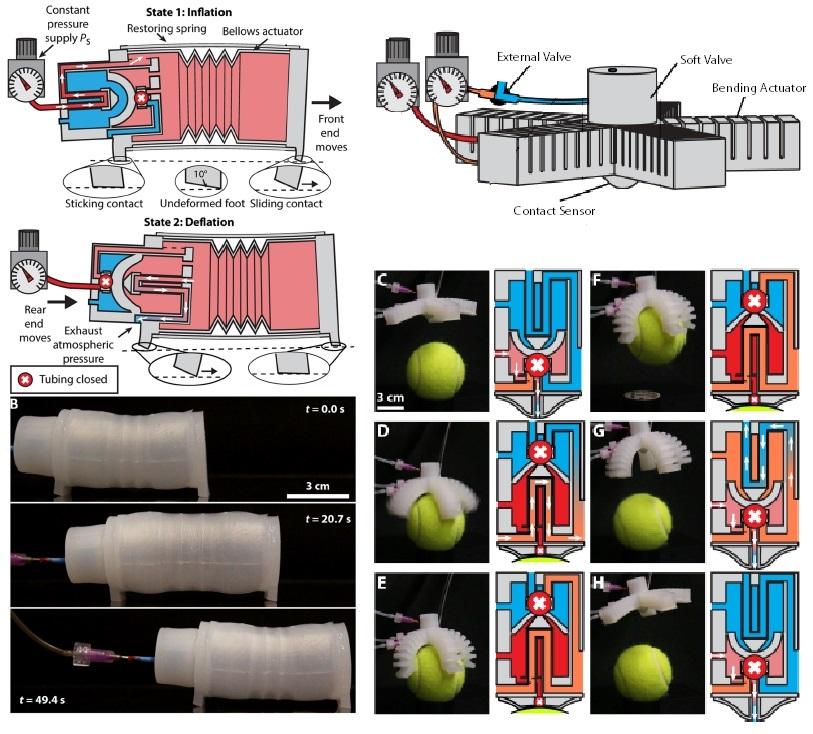
|
Fig. 10: At left: an autonomous soft robot with earthworm-like locomotion using an air source of constant pressure. The earthworm consists of a linear bellows actuator with a cylindrical sleeve as a restoring spring and a soft, bistable valve, integrated into the rear of the actuator. The bellows actuator bends upward during inflation and downward during deflation, which causes asymmetric contact between the feet and the ground, leading to asymmetric friction and directional movement. Photographs show the moving earthworm at three points in time. At right: An autonomous gripper, which consists of five bending actuators, connected to a ring-shaped channel, around a soft, bistable valve. |
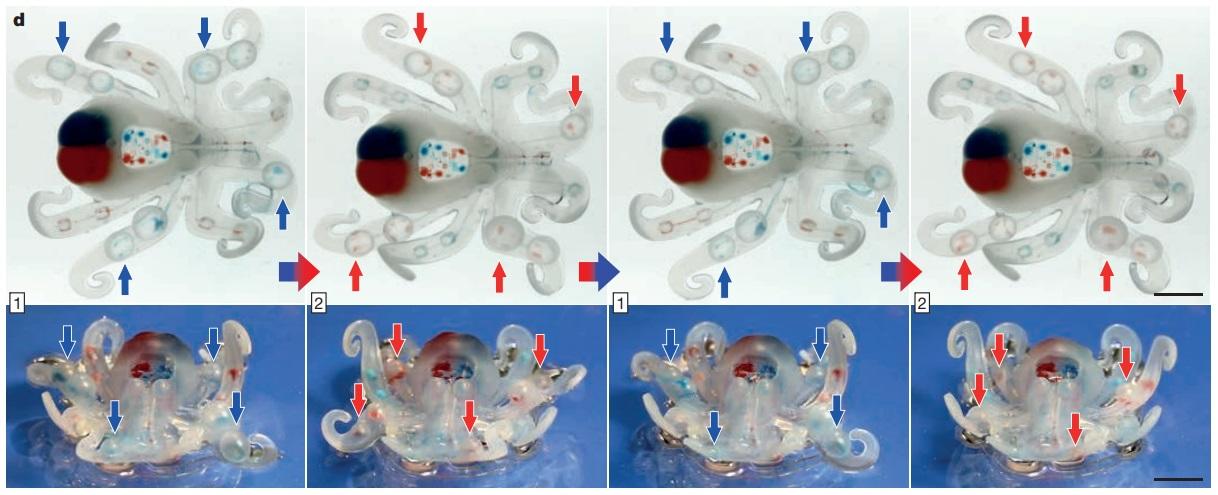
|
| Fig. 11: Stills from top-down and face-on show an octobot autonomously alternating between blue (‘1’) and red (‘2’) actuation states. Scale bars, 10 mm. |
We have developed hybrid robotics systems that combine hard and soft subsystems. One example (Figure 12) uses a wheeled robot (an iRobot Create; hard) and a four-legged quadruped (soft) [12]. It is capable (using a simple, wireless control system) of rapid locomotion over flat terrain (using the wheeled hard robot) and of gripping and retrieving an object (using the independent locomotive capabilities of the soft robot).
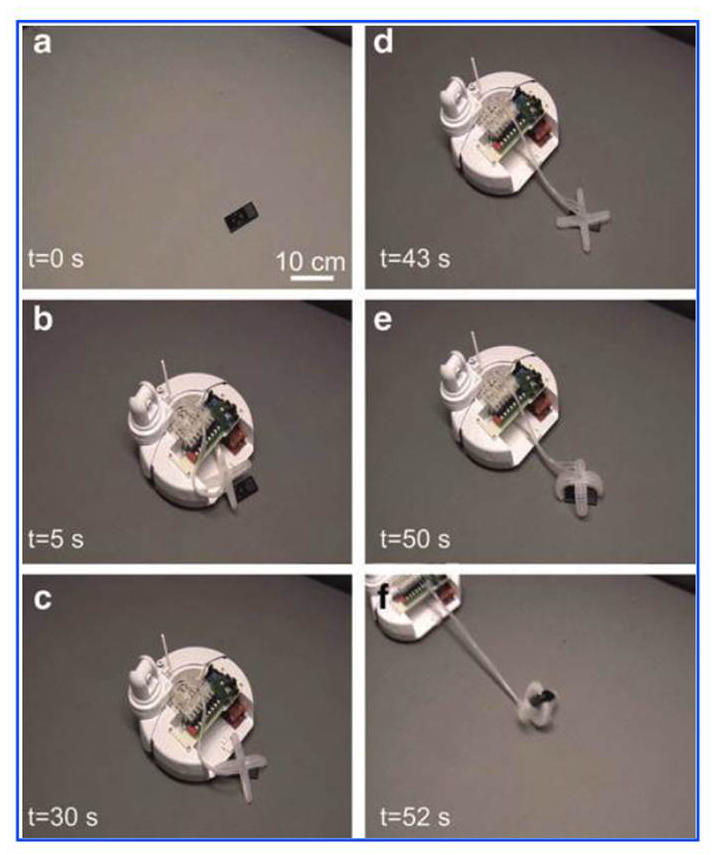
|
Fig. 12: A series of still frames show a hybrid robotic system retrieving an object (iPod Nano) from the center of a room (a–f). The hard robot carries the soft robot to the object (b). The soft robot first acts as a walker (c–d), and then as a gripper (e). When the hard robot is driven away (f), the soft robot inverts and protects the iPod as it is pulled to a new location. |
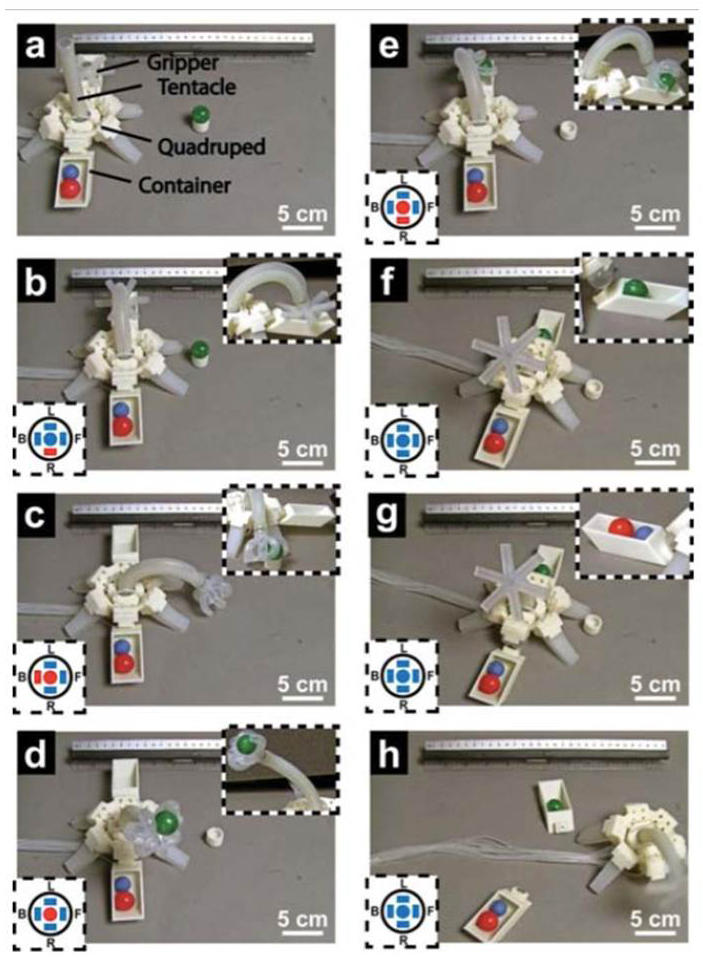
|
Fig. 13: Self-alignment of ring magnets enabled remote assembly of soft actuators, and connection of pneumatic channels for actuation of a soft-hard porter. Panels (a–h) show the top perspective view of the robot. Insets at the bottom left corner of panels (b–h) show the state of actuation of side and central channels of the soft tentacle. (a) A pneumatically actuated quadrupedal porter moved towards its target (green sphere). (b) Pneumatically actuated soft tentacle positioned its apex to connect a soft gripper embedded with a ring magnet. (c–e) The assembled tentacle-gripper picked up, and placed the green sphere into the left container for transport. (f, g) After moving forward for a short distance, the robot stopped. Actuation of the inflatable connectors unloaded the cargo together with the containers. (h) Robot continued its forward trajectory after the delivery of cargo had been completed. |
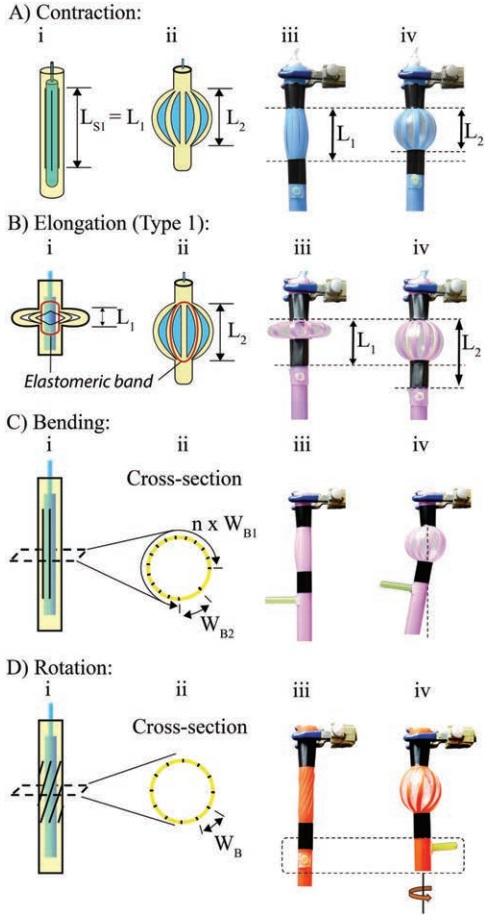
|
Fig. 14: Actuators with vertical slits that produce localized contraction, elongation, bending, or rotation, A) an actuator with eight slits that contracts, B) an actuator with eight slits, initially contracted by elastic rubber bands (red) that elongates upon inflation, C) an actuator with aperiodic vertical slits that bends. One quarter of its circumference was equally divided to two sections (by a single slit) and the rest was equally divided to eight sections, D) an actuator with eight vertical slits that rotates and contracts upon actuation. |
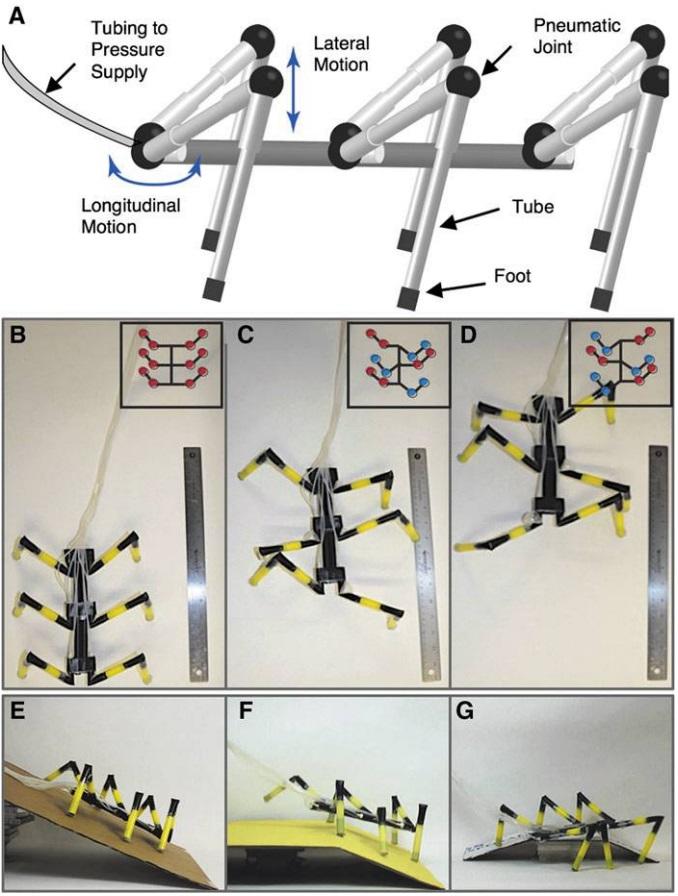
|
Fig. 15: A six-legged, walking arthrobot. (A) A schematic diagram showing design of the six-legged walker and the directions of motion for each joint. (B–D) A series of three photographs showing the alternating tripedal gait used by this six-legged arthrobot for forward locomotion. The ruler pictured is 38 cm long. (E) The six-legged arthrobot climbing a flat, cardboard surface inclined at 35 from horizontal; (F) The arthrobot navigating both inclining and declining terrain; (G) The arthrobot navigating a step. |
Beyond purely elastomeric actuators, we have also developed soft pneumatic actuators based on composites consisting of elastomers with embedded sheet or fiber structures (e.g., paper or fabric) that are flexible but not extensible [16]. Upon pneumatic inflation (Figure 16), these actuators move anisotropically, based on the motions accessible by their composite structures. They are inexpensive, simple to fabricate, light in weight, and easy to actuate. This class of structure is versatile: the same principles of design lead to actuators that respond to pressurization with a wide range of motions (bending, extension, contraction, twisting, and others). Paper, when used to introduce anisotropy into elastomers, can be readily folded into 3D structures following the principles of origami; these folded structures increase the stiffness and anisotropy of the elastomeric actuators, while being light in weight.

|
Fig. 16: A biased bellows actuator, fabricated by modifying the elongation actuator in Figure 5. a) The 3D bellows-like pattern of the paper, the same design in Figure 5. b) The fabrication process is similar to the one shown in Figure 5 except that the right edges of the paper structure were glued together. The elongation is possible from the left side of the device. c–e) The resting and actuated states of such a device under P1 = 60 mbar, P2 = 125 mbar, P3 = 175 mbar, and P4 = 250 mbar, respectively. f) Dependence of the angle θ on pressure after 50 cycles of pressurization/ depressurization. The small standard deviation (error bars) indicates that θ does not change significantly as a function of the number of cycles. |

|
Fig. 17: Assembly of click-e-bricks to form a multi-chamber soft machine and its operation. In this case the click-e-bricks were glued together by curing liquid Ecoflex pre-polymer adhesives applied at their interfaces. The click-e-bricks were made of Ecoflex. (a) Schematic illustration of the click-e-bricks used for assembling the device. Six of the click-e-bricks had four rectangular cutouts (dotted boxes labeled 1 to 4 in panel b, top view) that formed continuous chambers when stacked as shown in panel c. (d, i-viii) Operation of the soft machine. Inset at the upper left corner of each panel shows the state of pressurization of the four chambers. A black chamber is pressurized (ΔP ∼ 40 kPa) and a white chamber is not. Tubes routed through the side-walls of the device provided access to the internal chambers for delivering and venting of pressurized air. Each chamber required a single tube for pneumatic actuation. All scale bars are 1 cm. |
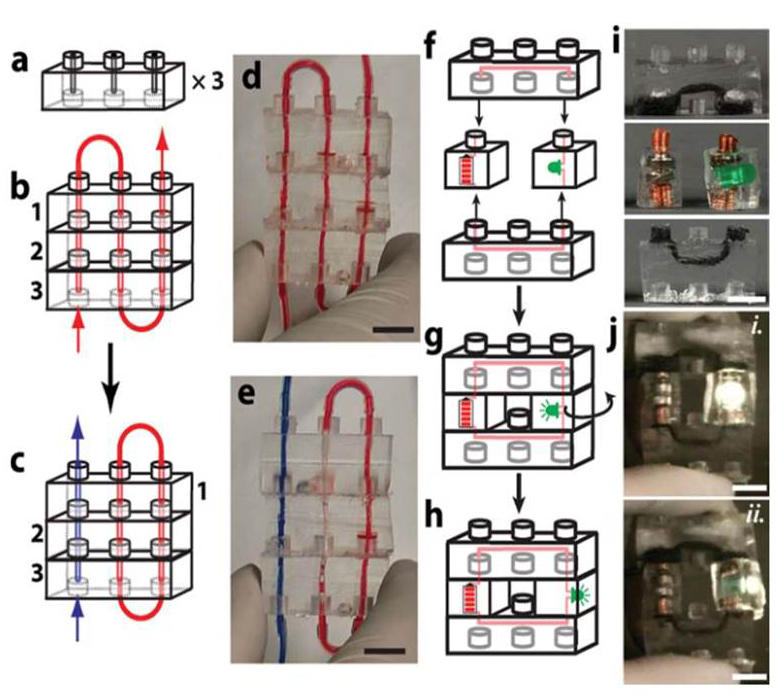
|
Fig. 18: Transport of liquid and electric current through click-e-bricks. (a-c) Schematics illustrating the assembly of a stack of three click-e-bricks with vertical microchannels. All click-e-bricks are fabricated from PDMS. The top and bottom click-e-bricks have inlet/outlet tubes to complete the fluid circuit. (d) Photograph of the assembly configured as shown in panel b. The microchannel is filled with a red colored aqueous solution. (e) Photograph of the assembly after the top click-e-brick from panel d is rotated 180° to achieve the configuration in panel c. The new fluidic pathway is filled with a blue colored aqueous solution. (f-h) Schematics illustrating the assembly of an LED circuit consisting of two electrically conductive, one battery, and one LED click-e-bricks. (i) Photographs of the four click-e-bricks and (j) the assembled circuit. Illumination of the embedded LED indicates the electric circuit is closed. |
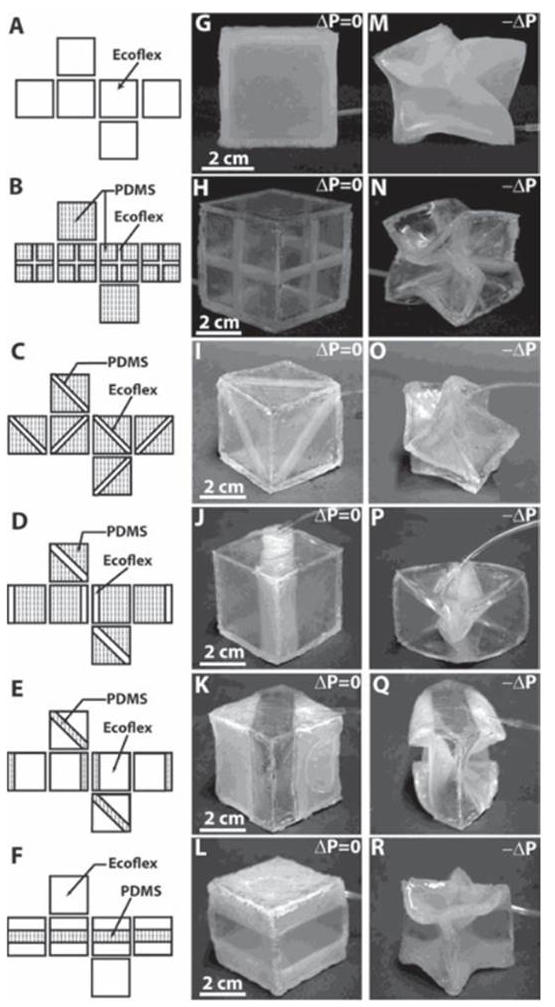
|
Fig. 19: Collapse of cubes fabricated with tiles comprising a single material and more than one material. (A−F) Schematic showing the tiles used to fabricate the cubes. The PDMS regions of the tile are marked with hatch marks and the Ecoflex regions are solid white. (G–L) Photographs of the cubes with no pressure applied. (M−R) Photographs of buckled cubes after negative pressure (−ΔP ∼ 35 kPa) was applied. |
1. Ilievski, F., A.D. Mazzeo, R.E. Shepherd, X. Chen, and G.M. Whitesides, Soft Robotics for Chemists. Angewandte Chemie-International Edition, 2011. 50(8): p. 1890-1895.
2. Shepherd, R.F., F. Ilievski, W. Choi, S.A. Morin, A.A. Stokes, A.D. Mazzeo, X. Chen, M. Wang, and G.M. Whitesides, Multigait soft robot. Proceedings of the National Academy of Sciences of the United States of America, 2011. 108(51): p. 20400-20403.
3. Martinez, R.V., J.L. Branch, C.R. Fish, L.H. Jin, R.F. Shepherd, R.M.D. Nunes, Z.G. Suo, and G.M. Whitesides, Robotic Tentacles with Three-Dimensional Mobility Based on Flexible Elastomers. Advanced Materials, 2013. 25(2): p. 205-212.
4. Mosadegh, B., P. Polygerinos, C. Keplinger, S. Wennstedt, R.F. Shepherd, U. Gupta, J. Shim, K. Bertoldi, C.J. Walsh, and G.M. Whitesides, Pneumatic Networks for Soft Robotics that Actuate Rapidly. Advanced Functional Materials, 2014. 24(15): p. 2163-2170.
5. Mosadegh, B., A.D. Mazzeo, R.F. Shepherd, S.A. Morin, U. Gupta, I.Z. Sani, D. Lai, S. Takayama, and G.M. Whitesides, Control of soft machines using actuators operated by a Braille display. Lab on a Chip, 2014. 14(1): p. 189-199.
6. Shepherd, R.F., A.A. Stokes, J. Freake, J. Barber, P.W. Snyder, A.D. Mazzeo, L. Cademartiri, S.A. Morin, and G.M. Whitesides, Using Explosions to Power a Soft Robot. Angewandte Chemie-International Edition, 2013. 52(10): p. 2892-2896.
7. Tolley, M.T., R.F. Shepherd, B. Mosadegh, K.C. Galloway, M. Wehner, M. Karpelson, R.J. Wood, and G.M. Whitesides, A Resilient, Untethered Soft Robot. Soft Robotics, 2014. 1(3): p. 213-223.
8. Yang, D., B. Mosadegh, A. Ainla, B. Lee, F. Khashai, Z.G. Suo, K. Bertoldi, and G.M. Whitesides, Buckling of Elastomeric Beams Enables Actuation of Soft Machines. Advanced Materials, 2015. 27(41): p. 6323.
9. Yang, D., M.S. Verma, J.H. So, B. Mosadegh, C. Keplinger, B. Lee, F. Khashai, E. Lossner, Z.G. Suo, and G.M. Whitesides, Buckling Pneumatic Linear Actuators Inspired by Muscle. Advanced Materials Technologies, 2016. 1(3).
10. Rothemund, P., A. Ainla, L. Belding, D.J. Preston, S. Kurihara, Z. Suo, and G.M. Whitesides, A Soft, Bistable Valve for Autonomous Control of Soft Actuators. Science Robotics, 2018. 3(16): p. 7986.
11. Wehner, M., R.L. Truby, D.J. Fitzgerald, B. Mosadegh, G.M. Whitesides, J.A. Lewis, and R.J. Wood, An integrated design and fabrication strategy for entirely soft, autonomous robots. Nature, 2016. 536(7617): p. 451.
12. Stokes, A.A., R.F. Shepherd, S.A. Morin, F. Ilievski, and G.M. Whitesides, A Hybrid Combining Hard and Soft Robots. Soft Robotics, 2014. 1(1): p. 70-74.
13. Kwok, S.W., S.A. Morin, B. Mosadegh, J.H. So, R.F. Shepherd, R.V. Martinez, B. Smith, F.C. Simeone, A.A. Stokes, and G.M. Whitesides, Magnetic Assembly of Soft Robots with Hard Components. Advanced Functional Materials, 2014. 24(15): p. 2180-2187.
14. Belding, L., B. Baytekin, H.T. Baytekin, P. Rothemund, M.S. Verma, A. Nemiroski, D. Sameoto, B.A. Grzybowski, and G.M. Whitesides, Slit Tubes for Semisoft Pneumatic Actuators. Advanced Materials, 2018. 30(9).
15. Nemiroski, A., Y.Y. Shevchenko, A.A. Stokes, B. Unal, A. Ainla, S. Albert, G. Compton, E. MacDonald, Y. Schwab, C. Zellhofer, and G.M. Whitesides, Arthrobots. Soft Robotics, 2017. 4(3): p. 183-190.
16. Martinez, R.V., C.R. Fish, X. Chen, and G.M. Whitesides, Elastomeric Origami: Programmable Paper-Elastomer Composites as Pneumatic Actuators. Advanced Functional Materials, 2012. 22(7): p. 1376-1384.
17. Morin, S.A., Y. Shevchenko, J. Lessing, S.W. Kwok, R.F. Shepherd, A.A. Stokes, and G.M. Whitesides, Using "Click-e-Bricks" to Make 3D Elastomeric Structures. Advanced Materials, 2014. 26(34): p. 5991.
18. Morin, S.A., S.W. Kwok, J. Lessing, J. Ting, R.F. Shepherd, A.A. Stokes, and G.M. Whitesides, Elastomeric Tiles for the Fabrication of Inflatable Structures. Advanced Functional Materials, 2014. 24(35): p. 5541-5549.
